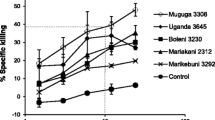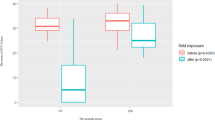Summary
Zebu cattle were immunised against East Coast fever (ECF) using three isolates ofTheileria parva inoculated as cryopreserved stabilates of infective particles harvested fromRhipicephalus appendiculatus. These isolates included the East African laboratory type strain,T. parva (Muguga), and two isolates ofT. parva from Entebbe, Uganda. Pairs of cattle received an inoculation of stabilate and were allowed to react and recover fortuitously, while groups of five cattle received both stabilate and were protected by chemoprophylactic therapy with oxytetracycline. An IFA serological response was elicited in 17 of the 21 stabilate recipients.
These 21 cattle, along with eight susceptible controls, were exposed to a massive and continuing natural challenge ofT. parva andT. mutans, accompanied by very heavy tick infestation in an ECF enzootic area at Kigungu, Entebbe. All eight controls died of ECF in a mean time of 25·6 days. The stabilate recipients were significantly protected, their mean time to death being 71·3 days. Only six of these 21 cattle died of theileriosis within 40 days of exposure and these included three which did not exhibit a serological response following inoculation of stabilate.
The implications ofT. mutans pathogenesis, unlimited heavy tick challenge and the potential value of complexes ofT. parva strains are discussed.
Résumé
Des zébus ont été immunisés contre la fièvre de la côte Est (ECF) à l'aide de trois souches deTheileria parva, injectées sous forme de stabilats congelés de particules infectieuses récoltées à partir deRhipicephalus appendiculatus. Ces souches comprennent la souche de laboratoire-type d'Afrique de l'Est—T. parva (Muguga) et deux souches deT. parva d'Entebbe, Ouganda. Des paires de bovins ont reçu une inoculation de ces stabilats et n'ont pas été traités, tandis que des groupes de cinq bovins ont reçu ces mêmes stabilats et ont été protégés par un traitement chimioprophylactique avec de l'oxytétracycline. Une réponse sérologique (réaction d'immuno-fluorescence indirecte) a été détectée chez 17 des 21 animaux inoculés. Ces 21 bovins, avec 8 témoins sensibles, ont été exposés à une infestation naturelle massive et continue par des très grands nombres de tiques infectées deT. parva etT. mutans dans une région d'enzootie à ECF à Kikungu, Entebbe. Les 8 témoins sont morts de ECF dans un temps moyen de 25.6 jours. Les bovins inoculés avec des stabilats ont été significativement protégés, leur délai de survie étant en moyenne de 743 jours. Seulement 6 de ces 21 animaux sont morts de theilériose en moins de 40 jours d'exposition et parmi eux s'en trouviaent 3 qui n'avaient pas réagi sérologiquement à l'inoculation de stabilat.
Les auteurs discutent des implications de la pathogénie deT. mutans, de l'infestation massive et illimitée par les tiques et de la valeur potentielle des combinaisons de souches deT. parva.
Resumen
Un grupo de ganado Cebú fue inmunizado contra theileriosis, utilizando tres cepas deTheileria parva, inoculadas con estabilados criopreservados de partículas infectivas extraídas deRhipicephalus appendiculatus. Estos aislamientos incluyeron le cepa patrón del Laboratorio Africano del Este,T. parva (Muguga) y dos cepas deT. parva de Entebbe, Uganda. Parejas de animales fueron inoculados con estabilados, mientras que grupos de 5 animales recibieron el estabilado y protección quimioterapéutica con oxitetraciclina. Se detectó una respuesta serológica con la prueba indirecta de anticuerpos fluorescentes “IFAT” en 17 de los 21 animales que recibieron estabilados.
Estos 21 bovinos, junto con ocho controles susceptibles, se expusieron a una descarga continua natural deT. parva yT. mutans, acompañada de una infestación alta de garrapatas en un área enzoótica en Kigungu, Entebbe. Los ocho controles murieron de theileriosis en un tiempo promedio de 256 días. Los animales inmunizados mostraron una protección significativa, muriendo de theileriosis en un tiempo promedio de 71.3 días. Solamente seis de los 21 animales murieron de theileriosis dentro de los 40 días después de la exposición, incluídos tres que no mostraron respuesta serológica después de la inoculación del estabilado.
Se discute también la implicación de la patogénesis deT. mutans, la exposición ilimitada a garrapatas y el valor potencial de complejos deT. parva.
Similar content being viewed by others
References
Brocklesby, D. W., Barnett, S. F. &Scott, G. (1961).British Veterinary Journal,117, 529–531.
Burridge, W. J. (1971).Research in Veterinary Science,12, 338–341.
Burridge, M. J. &Kimber, C. D. (1972).Research in Veterinary Science,13, 145–455.
Cunningham, M. P., Brown, C. G. D., Burridge, M. J., Irvin, A. D., Kirimi, I. M., Purnell, R. E., Radley, D. E. &Wagner, G. G. (1974).Tropical Animal Health and Production,6, 39–43.
Guilbride, P. D. L. &Opwata, B. (1963).Bulletin of Epizootic Diseases of Africa,11, 289–298.
Irvin, A. D., Brown, C. G. D., Burridge, M. J., Cunningham, M. P., Musoke, A. J., Peirce, M. A., Purnell, R. E. &Radley, D. E. (1972).Tropical Animal Health and Production,4, 220–229.
Jezierski, A., Lambelin, G. &Lateur, L. (1959).Bulletin D'Information de L'Ineac,VIII, 1–21.
Lutz, W. (1973). InApplication of Immunological Methods (ed. D. M. Weir), Appendix 1, A1.28, Blackwell Scientific Publications, Oxford.
Matthysse, J. G., Colbo, M. H. &Kamya, E. P. (1969).Bulletin of Entomological Research,58, 465–485.
Radley, D. E., Brown, C. G. D. Cunningham M. P., Kimber, C. D., Musisi, F. L., Payne, R. C., Purnell, R. E., Stagg, S. M. &Young, A. S. (1975a).Veterinary Parasitology,1, 51–60.
Radley, D. E., Brown, C. G. D., Cunningham, M. P., Kimber, C. D., Musisi, F. L., Purnell, R. E., Stagg, S. M. &Punyua, D. K. (1975b).Veterinary Record,96, 525–527.
Radley, D. E., Brown, C. G. D., Burridge, M. J., Cunningham, M. P., Kirimi, I. M., Purnell, R. E. &Young, A. S. (1975c).Veterinary Parasitology,1, 35–41.
Riek, R. F. (1957).Australian Journal of Agricultural Research,8, 209–214.
Snodgrass, D. R., Trees, A. J., Bowyer, W. A., Bergman, J. R., Daft, J. &Wall, A. E. (1972).Tropical Animal Health and Production,4, 142–151.
Thomas, A. D. &Neitz, W. O. (1958).Journal of South African Veterinary Medical Association,29, 39–50.
Uilenberg, G., Robson, J. &Pedersen, Val. (1974).Tropenmedizen und Parasitologie,25, 207–216.
Uilenberg, G., Schreuder, B. E. C., Silayo, R. S. &Mpangala, C. (1976).Tropenmedizin und Parasitologie,27, 329–336.
Van Rensburg, S. J. (1959).Journal of the South African Veterinary Medical Association,30, 75–95.
Author information
Authors and Affiliations
Additional information
FAO Staff Members.
Project supported by the United Nations Development Programme with the Food and Agricultural Organization of the United Nations as the Executing Agency, in co-operation with the Government of Uganda.
Project supported by the United Nations Development Programme with the Food and Agriculture Organization of the United Nations as the Executing Agency, in co-operation with the East African Community. The Project is also supported by the Ministry of Overseas Development of the United Kingdom (Research Projects R 2396, R 2494 and R 2845 A and B), the United States Department of Agriculture, the Rockefeller Foundation, the International Atomic Energy Agency and Pfizer International Inc.
Rights and permissions
About this article
Cite this article
Robson, J., Pedersen, V., Odeke, G.M. et al. East coast fever immunisation trials in Uganda: Field exposure of zebu cattle immunized with three isolates ofTheileria parva . Trop Anim Health Prod 9, 219–231 (1977). https://doi.org/10.1007/BF02240343
Issue Date:
DOI: https://doi.org/10.1007/BF02240343




